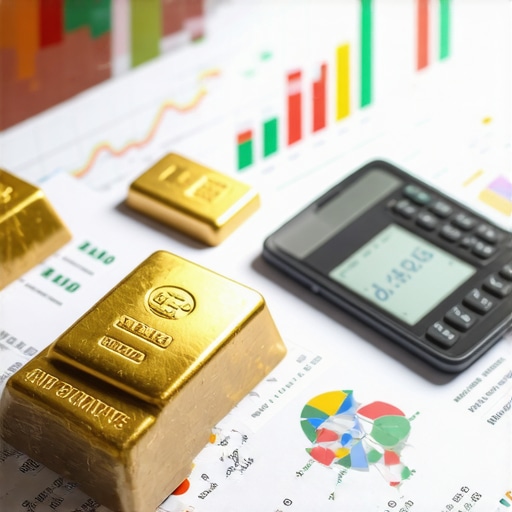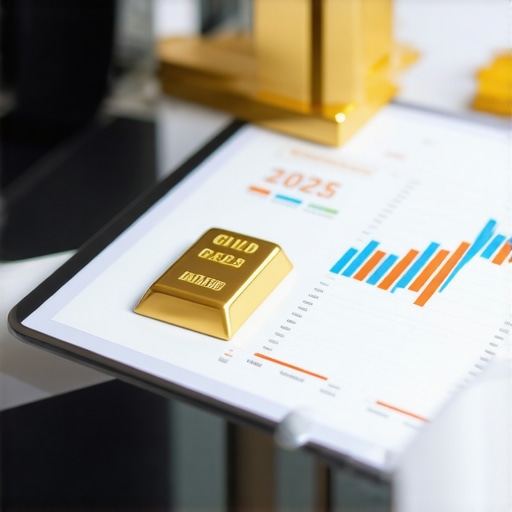Understanding Gold ETFs: An Overview
Gold Exchange-Traded Funds (ETFs) have become a popular choice among investors aiming to diversify their portfolios and hedge against inflation. These investment vehicles allow individuals to buy shares that represent a specific amount of gold, providing an accessible way to invest in precious metals without the need for physical storage. As we look to the future, it’s essential to explore the trends and predictions surrounding gold ETFs to better understand their potential impact on investment strategies.
What Are the Current Trends in Gold ETFs?
In recent years, gold ETFs have witnessed significant growth, driven by several factors. One major trend is the increasing interest in gold as a safe-haven asset, particularly during periods of economic uncertainty. Investors are gravitating toward gold ETFs to protect their wealth against market volatility and inflationary pressures. According to a report by the World Gold Council, global gold ETF holdings reached record levels in 2020 and maintained strong performance into 2021, indicating a robust demand for gold investments.
How Will Economic Factors Influence Gold ETFs?
Economic trends play a crucial role in shaping the future of gold ETFs. Factors such as interest rates, inflation, and geopolitical tensions can significantly impact gold prices and, consequently, ETF performance. For instance, low-interest rates often lead to higher gold prices as investors seek alternatives to traditional fixed-income securities. Additionally, with ongoing concerns about inflation, many investors view gold as an effective hedge, further boosting demand for gold ETFs.
Future Predictions for Gold ETFs
Looking ahead, analysts predict continued growth for gold ETFs, driven by both retail and institutional investors. As more individuals become aware of the benefits of gold as a portfolio diversifier, we can expect an influx of new investments in gold ETFs. Furthermore, advancements in technology and trading platforms are likely to enhance the accessibility and appeal of these investment options. Investors may also see the introduction of newer ETF products that offer exposure to gold mining companies or gold-related industries, expanding the possibilities within this asset class.
What Should Investors Consider When Investing in Gold ETFs?
Investors should conduct thorough research before diving into gold ETFs. It’s essential to compare different funds, considering factors such as management fees, performance history, and liquidity. Additionally, understanding the underlying assets and the ETF’s structure can help investors make informed decisions. For those looking to maximize their gains, effective gold trading techniques can be found in our article on Maximize Your Gains: Effective Gold Trading Techniques.
Conclusion: Preparing for the Future of Gold ETFs
As the landscape of gold investing continues to evolve, staying informed about trends and predictions is vital for making strategic investment decisions. With the potential for growth in gold ETFs, investors should remain proactive in understanding the market dynamics that drive these investments. What are your thoughts on the future of gold ETFs? Share your insights in the comments below!
What Are the Benefits of Investing in Gold ETFs?
Gold ETFs provide numerous advantages for both novice and seasoned investors. One of the significant benefits is liquidity; gold ETFs can be traded on stock exchanges just like stocks, allowing for quick and easy transactions. This liquidity makes it simple for investors to buy and sell shares, providing more flexibility compared to physical gold, which requires additional steps for buying and selling.
Moreover, gold ETFs often have lower expense ratios compared to traditional mutual funds. This cost-effectiveness, combined with the ease of trading, makes gold ETFs an attractive option for those looking to diversify their investment portfolios.
How Do Gold ETFs Compare to Physical Gold?
Investors often wonder whether they should invest in gold ETFs or physical gold. While both options offer exposure to gold, they cater to different investment strategies. Physical gold provides tangible assets that can serve as a hedge against inflation and economic uncertainty, while gold ETFs offer a more convenient and accessible way to invest in gold without the need for storage or insurance.
According to Wikipedia, gold ETFs allow for fractional ownership, making it easier for investors to access this precious metal without a substantial upfront investment. This democratization of gold investment is particularly appealing for younger investors or those new to the market.
Analyzing the Impact of Global Events on Gold ETFs
Global events, such as financial crises, geopolitical tensions, and major economic policy changes, significantly influence the performance of gold ETFs. For instance, during periods of crisis, gold often exhibits a flight-to-safety characteristic, leading to increased demand for gold ETFs. As seen in recent years, when uncertainties arose from pandemics or conflicts, gold prices surged, reflecting investors’ desire to safeguard their assets.
As we move forward, it’s important for investors to stay informed about global trends and events that may impact gold prices. Understanding the broader economic landscape will enable investors to make more informed decisions regarding their gold ETF investments.
What Are the Key Considerations for Future Gold ETF Investors?
Looking to the future, investors in gold ETFs should be mindful of several key factors. First, they should keep an eye on interest rates, as rising rates typically have an inverse relationship with gold prices. Additionally, changes in central bank policies, particularly regarding gold reserves, can signal shifts in market dynamics.
Investors should also consider the evolving landscape of gold ETFs, which may include new products that offer exposure to innovative sectors like gold mining companies or environmentally sustainable gold extraction practices. Staying abreast of these developments can provide a competitive edge in the investment landscape.
For those interested in maximizing their investments, exploring effective strategies for investing in gold can be beneficial. Check out our article on Gold Investment Strategies: What You Must Know for 2025 for more insights.
What Are the Key Drivers for Gold ETF Performance?
The performance of gold ETFs is influenced by several critical factors that investors should monitor. Firstly, global economic indicators such as inflation rates and currency fluctuations play a significant role. When inflation rises, gold is often seen as a reliable store of value, which can drive up prices. Additionally, the strength of the U.S. dollar can inversely affect gold prices; a weaker dollar typically makes gold more attractive to international investors, thus boosting demand.
How Do Central Bank Policies Affect Gold ETFs?
Central banks play a pivotal role in the gold market, and their policies can significantly impact gold ETF performance. For instance, when central banks increase their gold reserves, it signals confidence in gold as a safe-haven asset, which can enhance market sentiment and drive prices higher. A recent report by the World Gold Council highlighted that central banks have been net buyers of gold for several consecutive years, reinforcing its position as a critical asset in times of economic uncertainty.
People Also Ask: What Risks Should Investors Consider?
While gold ETFs offer many advantages, they are not without risks. One significant risk is market volatility, which can lead to rapid price fluctuations. Investors should be aware that while gold is often viewed as a safe haven, it can still experience sharp price corrections. Furthermore, the performance of gold ETFs can be affected by changes in regulatory environments or shifts in investor sentiment. Understanding these risks is crucial for making informed investment decisions.
Best Practices for Investing in Gold ETFs
To maximize the benefits of investing in gold ETFs, it’s essential to adopt a strategic approach. Here are some best practices:
- Diversify Your Investments: Consider a mix of gold ETFs and other asset classes to reduce overall portfolio risk.
- Monitor Market Trends: Stay updated on economic indicators and geopolitical developments that may influence gold prices.
- Evaluate Fund Performance: Regularly review the performance of your chosen ETFs, comparing them with industry benchmarks.
- Understand the Fees: Be aware of the management fees associated with your ETFs, as they can impact your overall returns.
By following these practices, investors can better position themselves for success in the gold ETF market.
Conclusion: Staying Ahead in Gold Investment
As the landscape of gold investing evolves, staying informed is paramount. Understanding the drivers of gold ETF performance, the implications of central bank policies, and the associated risks can empower investors to make strategic choices. Are you prepared to navigate the complexities of gold ETFs? Share your thoughts or questions in the comments below, and feel free to explore our related article on Essential Insights on Types of Gold Investments to Buy for more comprehensive guidance!
Why Should Investors Consider Gold ETFs in 2025?
With the ever-changing landscape of investment opportunities, gold ETFs stand out as a viable option for those looking to secure their financial future. As inflation concerns continue to loom and economic uncertainties persist, gold ETFs provide a hedge against market volatility. Additionally, they offer a unique combination of accessibility and liquidity, making them particularly appealing for both new and seasoned investors.
Key Factors Influencing Gold ETF Performance
Understanding the key drivers of gold ETF performance is crucial for making informed investment decisions. Market demand is one of the primary factors; as more investors seek exposure to gold, ETFs tend to perform better. Furthermore, global economic indicators, such as inflation and interest rates, play a significant role in shaping market sentiment. For instance, during times of high inflation, the demand for gold typically increases, which can drive up ETF prices.
What Are the Risks and Challenges of Investing in Gold ETFs?
While gold ETFs offer numerous advantages, they are not without risks. Market volatility can lead to unexpected price swings, which may affect investor confidence. Additionally, changes in regulatory policies and geopolitical tensions can also impact performance. Investors must navigate these potential challenges while remaining aware of the benefits that gold ETFs can provide.
According to Investopedia, it is essential for investors to conduct thorough research and stay informed about market trends to mitigate risks associated with gold ETF investments. By maintaining a proactive approach, investors can better position themselves for success in this dynamic market.
Strategies for Maximizing Returns with Gold ETFs
To optimize returns on gold ETF investments, consider implementing the following strategies:
- Stay Informed: Regularly monitor economic indicators and geopolitical developments to understand their implications on gold prices.
- Diversification: Incorporate a mix of gold ETFs within your investment portfolio to spread risk and enhance potential returns.
- Long-Term Perspective: Approach gold ETF investments with a long-term outlook, focusing on market fundamentals rather than short-term fluctuations.
By employing these strategies, investors can navigate the complexities of gold ETFs and make informed decisions that align with their financial goals.
Conclusion: The Future of Gold ETFs Is Bright
As we approach 2025, the future of gold ETFs looks promising. With increasing demand for gold as a safe-haven asset and advancements in trading technologies, investors are likely to see a broader array of investment options within the gold ETF space. Whether you’re just starting your investment journey or looking to enhance your portfolio, now is the time to consider gold ETFs as a strategic component of your investment strategy. Are you ready to embrace gold ETFs in your investment portfolio? Explore our article on Gold Investment Strategies: What You Must Know for 2025 to discover more insights!
Frequently Asked Questions (FAQ)
What are Gold ETFs and how do they work?
Gold ETFs, or Gold Exchange-Traded Funds, are investment funds that hold physical gold or gold-related assets. Investors can buy shares of these ETFs on stock exchanges, allowing them to gain exposure to gold prices without needing to store physical gold. The value of the ETF shares fluctuates based on the market price of gold, making it a convenient option for investors.
How do Gold ETFs compare to physical gold investments?
While both Gold ETFs and physical gold provide exposure to the gold market, they differ significantly. Physical gold requires secure storage and insurance, whereas Gold ETFs are traded like stocks and do not require physical possession. Additionally, Gold ETFs often have lower transaction costs and management fees compared to buying and selling physical gold.
What factors influence the price of Gold ETFs?
The price of Gold ETFs is primarily influenced by the market price of gold, which can be affected by factors such as inflation, interest rates, geopolitical tensions, and overall economic conditions. Additionally, demand for gold as a safe-haven asset during times of uncertainty can drive prices higher.
Are there risks associated with investing in Gold ETFs?
Yes, like any investment, Gold ETFs carry risks. Market volatility can lead to price fluctuations, and changes in regulatory policies could impact ETF performance. It’s essential for investors to conduct thorough research and understand the market dynamics before investing in Gold ETFs.
Can Gold ETFs be included in a retirement account?
Yes, Gold ETFs can typically be included in retirement accounts such as IRAs. However, investors should ensure they adhere to IRS regulations regarding investments in precious metals. It’s advisable to consult with a financial advisor for specific guidance on including Gold ETFs in retirement portfolios.
How can I choose the best Gold ETF for my investment strategy?
Choosing the best Gold ETF involves evaluating several factors, including expense ratios, fund performance, liquidity, and the underlying assets held by the ETF. Comparing different funds and understanding their management strategies can help you select the one that aligns with your investment goals.
What is the minimum investment required for Gold ETFs?
The minimum investment for Gold ETFs depends on the price of the ETF shares at the time of purchase. Since ETFs are traded on stock exchanges, investors can buy as little as one share, making it accessible even for those with limited investment capital.
How do I buy Gold ETFs?
To buy Gold ETFs, investors need a brokerage account. Once the account is set up, you can purchase shares of the ETF through your broker, similar to buying stocks. It is essential to research and choose the right ETF before making a purchase.
What are the tax implications of investing in Gold ETFs?
Investing in Gold ETFs can have tax implications. Generally, profits from selling ETF shares are subject to capital gains tax. Additionally, if the ETF holds physical gold, it may be classified as a collectible, which could be subject to a higher tax rate. It’s recommended to consult a tax professional for specific guidance.
Authoritative Sources
1. World Gold Council – A leading authority on gold and its investment potential, providing insights and research on market trends.
2. Investopedia – A comprehensive resource for financial education, including detailed information on Gold ETFs and investment strategies.
3. U.S. Securities and Exchange Commission (SEC) – The SEC provides essential information regarding investment regulations and guidelines for ETFs, ensuring investors are informed about compliance and risks.
Conclusion
In summary, Gold ETFs offer a unique opportunity for investors to gain exposure to gold without the complexities of physical ownership. By understanding the benefits, risks, and market dynamics influencing Gold ETFs, investors can make strategic decisions that enhance their portfolios. As we move into 2025, the potential for growth in Gold ETFs remains strong, making them a relevant option for diversifying investments. If you’re considering Gold ETFs, take the time to explore further and share your thoughts on this investment avenue in the comments below. For more insights, check out our article on Gold Investment Strategies: What You Must Know for 2025.










The article provides a comprehensive overview of gold ETFs as an accessible investment option, especially considering their liquidity and cost-effectiveness compared to physical gold. I’ve personally found that gold ETFs are a good hedge in my portfolio during times of inflation and economic uncertainty, as highlighted here. However, one aspect that merits deeper consideration is the impact of central bank policies on gold demand. When central banks increase their gold reserves, it tends to boost confidence in gold ETFs, but there can also be sudden regulatory changes or shifts in global financial policies which influence ETF performance unpredictably. For investors new to this space, understanding the underlying assets of each gold ETF and their management style is crucial to align with individual investment goals. I’d be interested to hear from others: how do you balance considerations like management fees and liquidity when choosing specific gold ETFs? Also, with technological advancements improving accessibility, do you think the market might soon see more niche gold ETF offerings, such as those focused on sustainable mining practices? It seems this could appeal to socially conscious investors while still leveraging gold’s traditional benefits.
Clara, you raised some compelling points about the influence of central bank policies on gold demand and the potential emergence of niche gold ETFs focused on sustainable mining practices. From my experience, balancing management fees and liquidity often hinges on understanding the ETF’s holdings and fund size. Larger ETFs generally offer better liquidity but sometimes come with higher fees, while smaller ones might be cheaper but harder to exit quickly. Regarding niche offerings, I’ve noticed a rising interest in socially responsible investing overall, so it seems logical that the gold ETF market will follow suit, creating more specialized funds that cater to ethical concerns without sacrificing gold’s traditional role as a hedge. However, one challenge might be ensuring these ETFs remain cost-effective and liquid enough to attract mainstream investors. I’m curious how others approach evaluating the trade-offs between pursuing sustainability-focused ETFs and sticking with classic gold funds primarily driven by performance metrics. Do you think the added value of ethical considerations in gold ETFs will outweigh potential liquidity or fee drawbacks in the near future?